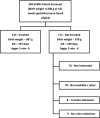Acute Kidney Injury Urine Biomarkers in Very Low-Birth-Weight Infants
- PMID: 27471253
- PMCID: PMC5012492
- DOI: 10.2215/CJN.13381215
Acute Kidney Injury Urine Biomarkers in Very Low-Birth-Weight Infants
Abstract
Background and objectives: Serum creatinine (SCr)-based AKI definitions have important limitations, particularly in very low-birth-weight (VLBW) neonates. Urine biomarkers may improve our ability to detect kidney damage. We assessed the association between 14 different urine biomarkers and AKI in VLBW infants.
Design, setting, participants, & measurements: We performed a prospective cohort study on 113 VLBW infants (weight ≤1200 g or <31 weeks' gestation) admitted to a regional neonatal intensive care unit at the University of Alabama at Birmingham between February 2012 and June 2013. SCr was measured on postnatal days 1, 2, 3, and 4 and was combined with clinically measured SCr to determine AKI according to Kidney Disease Improving Global Outcomes AKI definition (increase in SCr ≥0.3 mg/dl or ≥50% increase from previous lowest value). Urine was collected on the first 4 days (average number of urine collections, 3; range, 1-4). The maximum urine biomarkers and urine biomarker/creatinine levels were calculated for 12 urine biomarkers, and the minimum urine biomarker and biomarker/creatinine levels were assessed for two urine biomarkers. We compared these values between infants with and those without AKI. Ideal cutoffs, area under the receiver-operating characteristic curve , and area under the curve adjusted for gestational age were calculated.
Results: Cumulative incidence of AKI during the first 2 postnatal weeks was 28 of 113 (25%). Infants with AKI had higher maximum levels of urine cystatin C, neutrophil gelatinase-associated lipocalin, osteopontin, clusterin, and α glutathione S-transferase (2.0, 1.8, 1.7, 1.7, and 3.7 times higher, respectively) than infants without AKI. In addition, infants with AKI had lower minimum levels of epithelial growth factor and uromodulin than those without AKI (1.4 and 1.6 times lower, respectively). Most but not all participants had their maximum (or minimum) biomarker values preceding AKI. These associations remained after adjustment for gestational age.
Conclusions: Urine biomarkers measured in the first 4 days of life are associated with AKI during the first postnatal weeks. Further evaluations are necessary to determine whether these biomarkers can predict important clinical outcomes. In addition, intervention studies that use biomarkers to stratify enrollment groups are needed before bedside evaluations can be incorporated into care.
Keywords: KIM-1; NGAL; acute kidney injury; beta-2 microglobulin; biomarkers; child; creatinine; cystatin c; humans; infant, very low birth weight; intensive care units, neonatal; prospective studies.
Copyright © 2016 by the American Society of Nephrology.
Figures
References
-
- Selewski DT, Charlton JR, Jetton JG, Guillet R, Mhanna MJ, Askenazi DJ, Kent AL: Neonatal acute kidney injury. Pediatrics 136: e463–e473, 2015 - PubMed
-
- Askenazi DJ, Zappittelli M: The role of biomarkers in the management of acute kidney injury. Clin Lab Int 32: 16–18, 2009
-
- Liu KD, Thompson BT, Ancukiewicz M, Steingrub JS, Douglas IS, Matthay MA, Wright P, Peterson MW, Rock P, Hyzy RC, Anzueto A, Truwit JD; National Institutes of Health National Heart, Lung, and Blood Institute Acute Respiratory Distress Syndrome Network : Acute kidney injury in patients with acute lung injury: Impact of fluid accumulation on classification of acute kidney injury and associated outcomes. Crit Care Med 39: 2665–2671, 2011 - PMC - PubMed
Publication types
MeSH terms
Substances
Grants and funding
LinkOut - more resources
Full Text Sources
Other Literature Sources
Research Materials
Miscellaneous


